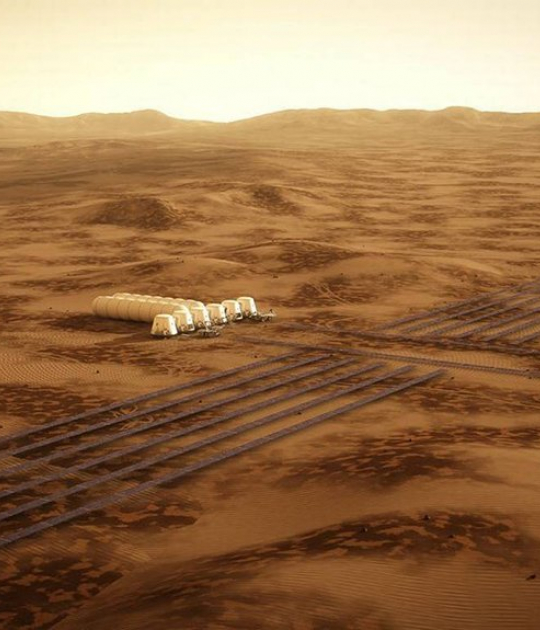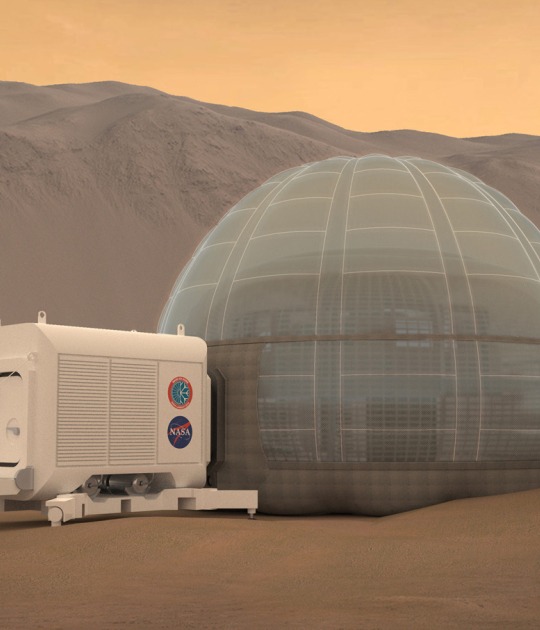The exhibition also questions whether we should be designing for Mars at all. In an installation modelling an alternative scenario running over a million years, Dr. Alexandra Daisy Ginsberg uses a gaming engine to simulate Mars colonised only by plants, not humans.
The Design Museum invites visitors to discover the role that design will play in humanity’s journey to the Red Planet in the exhibition ‘Moving to Mars’, which opens today. Every detail of this extraordinary venture must be designed – from the journey (around seven months), to considering what we will wear, eat and shelter in when we get there and beyond.
Conditions on Mars are deeply hostile to humans, and yet we appear to be determined to go. From the first photographic fly-by of Mars by Mariner 4 in 1965 to today’s enterprises, such as NASA and ESA’s Orion project and the private SpaceX venture, getting humans to Mars has become one of the greatest challenges of our time, especially in terms of design.
Mars is the most striking planet in the night sky and it has captivated our attention since antiquity. The exhibition begins with ‘Imagining Mars’, revealing the many ways we have looked at Mars from the earliest mentions in a cuneiform tablet from the British Museum to the first maps of Mars by Giovanni Schiaparelli, through to science fiction and popular culture. It includes a full-scale model of the European Space Agency’s ExoMars Rosalind Franklin rover. Visitors then have a chance to glimpse the hostile environment of Mars in the ‘On Mars Today’ multisensory installation which includes a scent ‘Utopia Planitia’ from French perfumer, Nicolas Bonneville of Firmenich that has been made especially for the exhibition.
The exhibition will also tackle The Voyage, looking at the role designers play in the journey. From food trays by NASA to Galina Balashova’s designs for Russian space interiors from 1964 to 1980, to Raymond Loewy’s design work for space stations and – exhibited for the first time – the NDX-1 space suit, designed specifically for the surface of Mars by the University of North Dakota. The challenges of dining in space are addressed in a newly commissioned spacecraft table by German industrial designer Konstantin Grcic, inspired by the constraints imposed by zero gravity.
The next section ‘Survival’ is where visitors will also be able to enter a full-scale Mars habitat for the first time – designed by London-based architecture firm HASSELL as part of NASA’s 3D-Printed Habitat Challenge. The habitat will be equipped with clothing from RÆBURN’s Spring/Summer 2020 NEW HORIZON collection, including pieces RÆMADE from solar blankets and parachutes, taking inspiration from the make-do-and-mend approach on Mars. This section will also look at farming on Mars through hydroponic farming kits and Spirulina-growing systems.
In the penultimate ‘Mars Futures’ section visitors enter the more speculative realm with a provocative new installation by Dr. Alexandra Daisy Ginsberg that imagines ‘wilding Mars’ by just sending plant life to the planet – not humans.
Justin McGuirk, Chief Curator at the Design Museum, said: “On the 50th anniversary of the Moon landing, we are entering a new space age, with Mars once again capturing the popular imagination. As a museum interested in emergent futures, we are keen to explore how designing for space can help us design for Earth.”
In the final section, Down to Earth, visitors will be faced by a stark choice – should we go to Mars?
For families, a Mars Mission will take children aged 8+ through a series of design briefs set by design and space specialists including European Space Agency astronaut Tim Peake. With hands-on challenges, younger visitors will have a chance to hone their design skills and use their creativity to solve some of the greatest design challenges of our times.







































